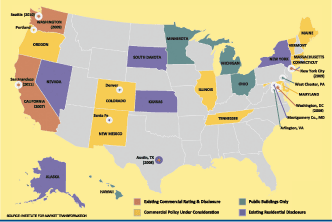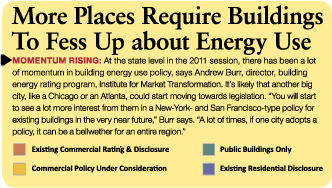Better Buildings Initiative sets new Energy Information Reporting Standards
Announced during the State of the Union address, the Better Buildings Initiative seeks to make commercial buildings 20 percent more energy efficient by 2020 through energy upgrades. The proposal immediately created excitement and garnered support from the commercial real estate sector. "People are excited and they should be," says Burr. "It will spur new private investment in energy efficiency in buildings. It will create a lot of jobs. This is exactly the type of initiative that we need right now to prove to a lot of people that increasing the energy efficiency of buildings is good economic policy, good environmental policy, and good jobs policy."
The parts of the president's proposal that need funding were submitted to Congress as part of the federal budget for fiscal year 2012. But the fate of that budget is far from certain. An analysis of the budget released in April by the Congressional Budget Office is less than glowing, citing increased deficits. As of this writing, Congress is awash in budget proposals, and there is no obvious indication of a likely winner.
Mired in this limbo are the aspects of the Better Buildings Initiative that have garnered the most praise. The first is transforming the existing commercial building tax deduction — which was added into the tax code under EPAct 2005 — into a tax credit and increasing the program by $1 billion.
According to Architecture 2030, a non-profit organization focused on reducing the green house gas emissions from the building sector, the proposed tax credits for meeting energy reductions below ASHRAE 90.1-2004 break down as follows: $.60 per sq. ft. for a 20 percent to 29 percent reduction, $.90 per sq. ft. for a 30 percent to 49 percent reduction, and $1.80 per square foot for a reduction of 50 percent or more.
Also included in the proposed budget are efforts to increase available financing for commercial retrofits. One example is a pilot loan guarantee program through the Department of Energy to fund loans to schools, hospitals and commercial buildings for energy efficiency retrofits. If passed as proposed, this would be funded at $2 billion.
"Race to Green" is another component that would require funding. With this, the administration is trying to make a pot of money available to states and cities that can demonstrate good policies and programs to increase the efficiency of local building stock, says Burr, whose organization is doing a little bit of work on this component.
"Budgets are tight, so any additional money can be very helpful," Burr says. "States and cities are thinking about financing policies that need seed money, the implementation costs for certain policies, the planning costs that need to be done with a lot of these policies. To the extent that federal money can be made available, that's a very good thing."
No Money Down Needed
Fortunately for facility managers, there are components of the Better Buildings Initiative on which the administration can easily move forward on its own. One of these is the "Better Buildings Challenge," which is still being hashed out but will involve CEOs and university presidents committing to a series of actions to make their facilities more efficient.
The administration is also working on increasing training in building energy audits and building operations. The New York Institute of Technology recently started a program that positions it to serve this need. "We just instituted a green FM training program, targeted at displaced workers, putting them in the position to be employed when these tax credits go into effect," says Robert Amundsen, director of the masters in energy management program at the institute. "Any time there's a tax credit program, you have to demonstrate that the retrofits you're making fit the requirements of the program. Just to develop each of these proposals and meet the requirements requires training that people currently don't have."
Still Work to Complete
In a sense, it's a good thing for individuals hoping to meet the needs of the Better Buildings Initiative that much of it requires finalizing and approval, since training takes time. As well, preparing projects to be "shovel ready" takes time. "It's always difficult to predict how long it's going to take legislation to work its way through Congress and be incorporated into the tax code," Amundsen says. "It's still a good idea to survey facilities that you already have and try to identify some of the opportunities so that when the credits do become available, you're in the position to take advantage of them."
While many would prefer cohesive direction and immediately actionable initiatives from the federal government on building energy efficiency, things are moving forward with or without Congress' approval. For example, Hooper points to 2005 and the Conference of Mayor's Climate Protection Agreement as a point when consensus started to gather.
"Cities have been recognizing that the vast majority of people live in cities these days and the vast majority of carbon emissions come from those cities, so it's important to have local leadership until the time is right for national leadership," Hooper says. "We definitely would support the President's plan and hope it comes to fruition. But we're not waiting."

Download a PDF version

Download a PDF version
Related Topics:










